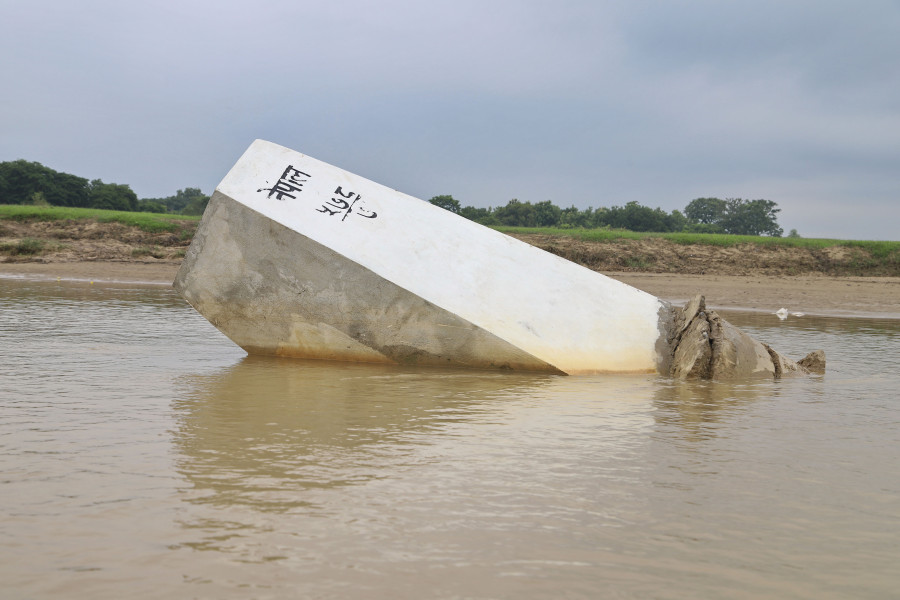Politics
Nepal and India are unlikely to meet the 2022 deadline for completing bilateral boundary work
The sixth meeting of the Boundary Working Group in Dehradun this week will review the progress made so far.
Anil Giri
Nepal and India are set to miss the 2022 deadline for completing the bilateral boundary work. The deadline was set by the highest-level joint technical body entrusted with the construction, restoration and repairing of boundary pillars, including the clearance of ‘no-man’s land’.
Initially, a meeting of Survey Officials’ Committee in Dehradun in December 2015 had agreed to complete the remaining works, except in Susta and Kalapani, the most contentious border points between Nepal and India, within four years—by 2019. The fourth meeting of the Nepal-India Boundary Working Group, held again in Dehradun two years later, had decided to complete the work by 2022, citing a lack of adequate progress in the fieldwork.
The last meeting of the group held in Kathmandu last year had also set the same 2022 deadline.
The Boundary Working Group is holding its sixth meeting this week in Dehradun, India where officials from both sides will review the groundwork undertaken by the joint technical teams, the status of pillar maintenance and inventory of cross-holding of properties by citizens of Nepal and India.
The Nepali team will be headed by Prakash Joshi, director general at Department of Survey, and officials representing various government offices at the meeting.
According to Joshi, officials at the Dehradun meeting will review the progress made in the last one year and chart out a new work plan for the coming year.
“We have made some good progress in field work,” Joshi told the Post. “We may not complete the work by 2021-end or within 2022, so we may require an additional one or two years. But we are on the right track.”
To complete the boundary work, Nepal and India had formed three teams—the Boundary Working Group, Survey Officials’ Committee and Joint Field Survey Teams—in 2014.
But the teams were mandated to work on locations except for Susta and Kalapani, which cover 40km land along the 1,751-km Nepal-India border. A panel at the foreign secretary-level is working to find an amicable solution on these two points.
The technical teams deployed in the field were tasked with constructing, restoring and repairing boundary pillars, clearing the no-man’s land, GPS mapping of boundary pillars, collecting data of property holdings across the border and resolving other boundary disputes.
Several reasons, including lack of funds to deploy officials in the field, frequent transfer of officials, technical hiccups and difficulty in finding the exact inventory of cross-holding of properties in bordering areas had led to the delay in the work though.
Both sides have deployed four separate teams in four different sections to settle the row over boundary pillars. Of the four teams, the first was assigned to keep a record of pillars; the second to reconstruct missing or damaged pillars; the third to clear the no-man’s land, handle property holding issues and conduct inventory; and the fourth was assigned to study GPS and co-ordinate the border pillars and boundary along with the maps prepared by both sides.
The construction, restoration and repairs of boundary pillars would be done via GPS with the reference of 182 sheets of maps prepared by both sides in 2007.
On the basis of these 182 sheets of strip maps, officials are fixing the border pillars, clearing the no-man’s land and reconstructing the missing or damaged pillars.
The field survey teams have completed their tasks in six of the 27 districts.
Officials at the Department of Survey said though half of the work has been completed in the last five years, it is still unlikely to meet the 2022 deadline.
“The way we are working, there is still doubt we can complete the work by 2022,” said Damodar Dhakal, spokesperson for the Department of Survey.
The BWG was constituted in 2014 to undertake field work related to finalising the Nepal-India boundary during Indian Prime Minister Narendra Modi’s visit to Nepal to resolve pending Nepal-India boundary issues once and for all.
The meeting will provide inputs to respective foreign secretaries to work on the outstanding boundary issues, including on Susta and Kalapani, on priority basis and take technical inputs from the BWG where necessary.
Apart from installing border pillars with global positioning system on all the 8,554 border pillars, the BWG has another mounting task of suggesting both governments on the issue of cross-holding of properties owned by people living in the bordering areas on both sides.
“If we increase the number of teams and speed up work in the field, maybe we can meet the deadline. But we have to install border pillars in major rivers, which is a tedious task,” said Dhakal.
Apart from installation of new border pillars, maintenance of old, damaged pillars and clearing of the no-man’s land, the BWG is facing a tough time completing the inventory of cross-holding of properties in the bordering areas.
People living on the Nepali side in bordering areas until now have to shift to the Indian side after the demarcation. There are similar problems with people living on the Indian side.
In such cross-holding cases, the BWG will manage the problem by providing various options. Due to the changes in the course of hundreds of rivers, thousands of hectares of land have slipped either side of the border whose data is collected by the Survey Officials’ Committee and Joint Field Survey Teams.
The people on either side will be given the choice to decide where they want to live. If a Nepali family's location shifts to the Indian side after the demarcation, they will be given an option to decide whether they want to permanently live in India or in Nepal. If a family wants to shift from either country, they will be given a year's time to sell their properties and resettle in the country of their choice, according to officials. Officials from both sides will conduct a local valuation of the land and compensate them for the resettlement.
The Department of Survey data shows Nepal and India have installed 8,554 pillars along the border. Of these, 1,325 are missing and 1,956 are damaged.
“Around 3,008 new pillars are yet to be constructed,” said Joshi, “and work to complete the inventory of cross-holding of properties in the bordering areas remains.”
***
What do you think?
Dear reader, we’d like to hear from you. We regularly publish letters to the editor on contemporary issues or direct responses to something the Post has recently published. Please send your letters to [email protected] with "Letter to the Editor" in the subject line. Please include your name, location, and a contact address so one of our editors can reach out to you.




 15.76°C Kathmandu
15.76°C Kathmandu















